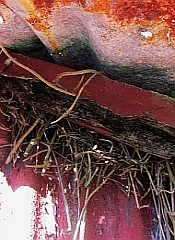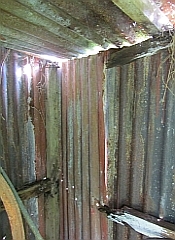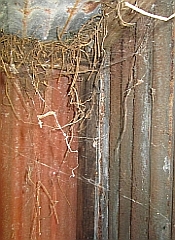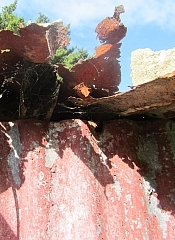 |
| Restoration of the Pumphouse |
|
Our Starting Point |
|
The pumphouse was built and the pump installed soon after Williams House was completed. Photographs taken in the 1920s show the pumphouse in its present location. Early photographs also show that it had a corrugated iron water tank installed on the roof. However, this had long gone by the time the Salmond Report was compiled. The purpose of this tank is unclear, but it would probably have been there as a header tank for watering the rear gardens. How the pump was initially operated is unknown, but it would have required some form of mechanical attachment. Probably at the time electric power was connected to the house, an electric motor would have been added to the pump. At that time the pole and overhead power wires would also have been added. |
|
Since it was built, the pumphouse probably would have had very little maintenance over the years and the state of decay presented at the time restoration was started meant that the whole structure would have to be rebuilt. |

|
|
The photograph at left was taken in 1996 when Salmond Architects were researching their report. By this stage a jasmine creeper had taken firm hold of the pumphouse and the power pole standing next to it. Following publication of the Salmond Report restoration work started on Williams House and the gardens. At that time the jasmine was removed from the outside of the pumphouse and the pole. Unfortunately the jasmine was quite well involved with the framework of the pumphouse and those parts had to be left in place while the rest was cut away. Over the course of the next 15 years, the now dead jasmine slowly released its hold on the pumphouse. Unfortunately the jasmine was the only thing holding it together. Add in the occasional tropical storm passing |

|
|
through the area and collapse was inevitable. At the final stage of deterioration, the roof was being held down with large blocks of concrete. The roof joists had long since given way and constant attention was being needed to keep the roof in place. It was decided that restoration could no longer be delayed. A new frame would have to be constructed to replace the existing. This would involve sourcing similar native timbers for the frame. As a last resort, we may have had to resort to modern treated timber. Replacement corrugated iron sheets and also lead-head nails to fix the iron in place would have to sourced, as nothing usable of the existing cladding would be suitable for re-use. |
|
Inside the pumphouse, even though the ravages of time were very evident in the state of the wooden framework. The pump itself was in fairly good condition. The pump paintwork had flaked off and surface rust was evident, but over forty years of disuse had not caused much of a restoration problem. The pump flywheel still turned and the pump shaft still seemed to move freely in the well bore. What we weren't able to see yet was whether or not the pump rod was still intact in the bore. It may have broken off leaving the lower part of the rod dropped down in the bore. Also the state of the bore itself could not be determined yet. Electric power had been disconnected from the pumphouse and would have to be reconnected to run the pump to see if we could still pump water before proceeding further. The electrical wiring itself looked to be intact, as did the overhead drop wires from the house to the pumphouse. However, the totara pole used to support the overhead wires would definitely need to be replaced, if power was to still be supplied via the overhead wires. |
|
Once we had determined whether or not water can be pumped, we would need to have the pump rod lifted out of the bore. That would enable an assessment to be made as to the viability of the bore. If the bore had collapsed, it may have been beyond financial resources to replace it. If that was to be the case, our restoration efforts would be directed towards a display that can be viewed by visitors. This final step would occur regardless of the outcome of the water pumping viability checks. |

|
|
In the opposite side of the pumphouse was the pressure vessel. Water was pumped into the pressure vessel to provide a supply of water at a constant pressure. A pressure switch wired to the pump switched it on or off as required. All of the wiring appeared intact, but it and the pressure vessel would have to be checked to see if replacement was necessary. If the pressure vessel needed to be replaced, a modern replacement would have to be used because we would probably be unable to source an original style replacement. Another unknown at this stage was whether or not the supply pipes were still intact. We also had the problem of not knowing where the pipes actually went. Neither of those problems was insurmountable, but if the pipes needed to be replaced they would have to be replaced with modern materials, such as alkathene (low density polyethylene) pipe. The original water supply fittings in some cases were still fitted to the pipe work. While originals would have been good, any other parts required could possibly be found for re-installation, either from |

|
|
second-hand suppliers or by using modern equivalents. Restoration to this stage would have achieved our primary aim, which was to restore the pump to working condition so that water could be pumped to irrigate the gardens. With the pump supplying the water required for the gardens, they would then be watered in a similar fashion to the way the Williams family would have done until the water main was connected in 1969, (approximately). However, we planned for one further step. The last part of the restoration project would be to install an automatic sprinkler system to enable watering of the gardens around Williams House, that required only minimal intervention to maintain a regular irrigation supply to the gardens regardless of availability of volunteers. Options for this are still being discussed. Should we not be able to restore the pump to supply water, this last stage would probably still proceed, with the supply instead being the water main connected to Williams house. |
|
Rebuilding The Pumphouse |
|
Before starting out on the restoration project, we had to consider two documents covering the conservation of the Williams House site; (a) the ICOMOS New Zealand Charter for the Conservation of Places of Cultural Heritage Values; and (b) The conservation report for Williams House written in 1997 by Salmond Architects. So, with those two documents in mind, we had no doubts; this was going to be a major rebuild project. The roof was being held down by large concrete blocks. Some of the walls were only still there because the corrugated iron cladding had not given way, had driven into the ground and were holding what was left of the roof up. The inside frame had disappeared in a lot of places due to the ravages of wood borer and fungal rot. There was nothing of the old pumphouse that could be salvaged for use in the new pumphouse; not even the hinges from the door. |

|

|

|

|
|
The Salmond Report had recommended that the pumphouse be considered as an item of considerable significance. This meant that it should preserved and protected as long as there was no conflict with the conservation of item of higher significance. Any maintenance, stabilisation, restoration, reconstruction, or reinstatement should comply with the ICOMOS charter. Under the ICOMOS charter our project would be considered reconstruction, which would allow the use of modern materials. However, we made the decision to use materials similar to the original materials so that the completed project was as close to the original as possible. So the next step was to source native timber for the framework and replacement power pole. An approach was made to the Far North District Council for assistance regarding supplies of native timbers from other projects. However, the FNDC agreed to fund the supply of new timber for the project and supplied contact details for a contractor. So, we had a supply of native timbers for the project. Corrugated iron cladding was donated for the project. While this had been used, it was in fairly good condition and would suit the project well. New lead-headed nails were found for fixing the cladding and a supply purchased. Finally, somewhere to get the pump and bore assessed and restored was found. The project could now begin. The first step was to remove the pump and pressure vessel. The pump rod could then be withdrawn from the bore for assessment of the viabilty of the bore. Luckily the pump rod was intact and the bore was in good condition. The old pumphouse could now be removed. While the pump and pressure vessel were taken away for restoration, work rapidly moved ahead. |
|
So, after demolishing the whole pumphouse and removing the pump and pressure vessel, we were left with the old concrete pad and not much else. To protect the bore, while the rebuild stage was being prepared, the bore was covered with on old sheet of corrugated iron weighted down by the concrete blocks used previously to hold the roof down. Following this new footings for the frame had to be constructed. At this stage the opportunity was taken to remove the old concrete pad and replace it with a new pad of the same size as the pumphouse footprint. The new frame design was based on what was left of |

|
|
the old frame; with one minor difference. On the recommendation of Gibson's Irrigation, who were restoring the pump, the roof section was made removable. In this was easy access could be gained to the pumphouse if ever the pump rod had to be lifted out of the bore in future. Due to changes with the internal power wiring within Williams House itself, the overhead power connection to the pumphouse was no longer connected in the house. Therefore the decision was made to provide an under-ground connection to the pumphouse from the nearby garage. However, the restoration of the power pole and the overhead wiring would still proceed to complete the overall restoration as near as possible to the original. |

|

|

|
|
After about two months work the new pumphouse completed and it was given a coat of red paint to match the colour scheme of the other on-site buildings. All that remained now was to install the reconditioned pump. The final step in the pumphouse restoration was to install a new totara post next to the pumphouse to simulate the original power connection. As mentioned previously this is for historical authenticity only. |

|

|
|
Reinstallation of the Reconditioned Pump |
|
While the pumphouse was being rebuilt, the pump itself had been sent for assessment and reconditioning. Apart from the obvious signs of surface rust and flaking paint from lack of maintenance for over 20 years, the pump was in surprisingly good condition. The contractor stripped the pump down and treated the metal parts to stop corrosion. The bearings were checked and refurbished where necessary. The leathers on the pump shaft that brought water to the surface were replaced, [for a description of how the pump works see here]. Finally all the metal parts were given a coat of paint as near as possible to the original colours. Finally the pump was reassembled, but due to the rebuilt pump-house not being ready at this time, it was put on display in the showroom, where it drew many admiring glances from customers. The assessment of the pressure vessel, however, revealed that a replacement vessel would be needed. The original was too badly corroded and would have been very costly to restore. Coupled with |

|
|
that was the need to get the |
|
pressure vessel tested and certified, which was also a costly process. So the decision was made to replace the pressure vessel with a more modern fibreglass version. While a lot smaller than the original, the new pressure vessel would supply the required volume and pressure of water for our intended needs of watering the gardens of Williams House. When the pumphouse rebuild had been completed the pump was returned to Williams House and lifted into place. Power was re-connected to the pump and the whole system was tested. It met all our expectations and will be in service for many years to come. Our primary aim to restore the pump to working condition, so that water could be pumped to irrigate the gardens, has been achieved. With the pump now supplying the water required for the gardens, the demand on the connected water main supply has been reduced and the gardens are now being watered in a similar fashion to the way the Williams family would have done until the water main was connected in 1969. |

|

|